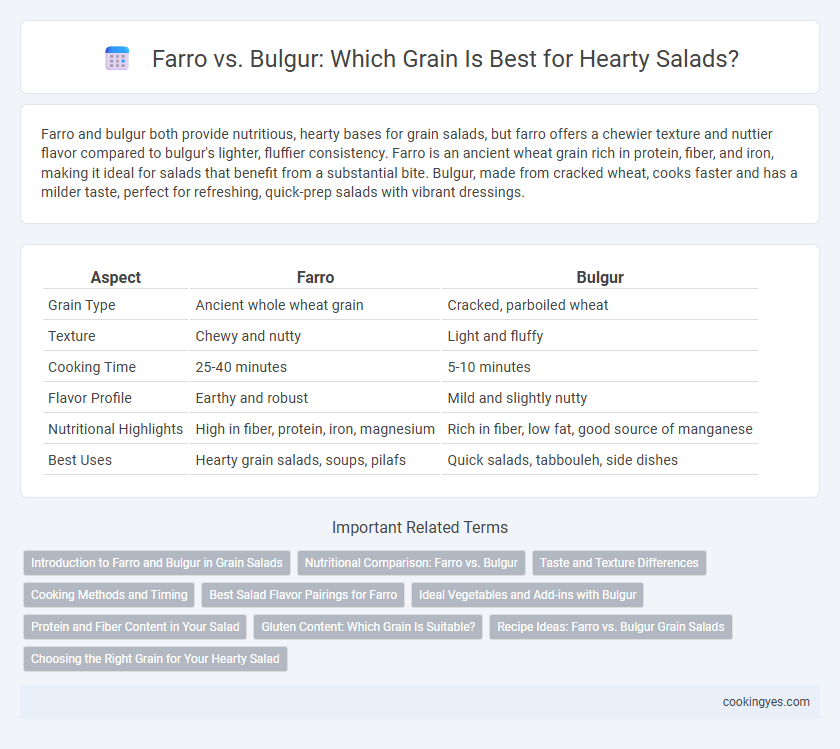Farro and bulgur both provide nutritious, hearty bases for grain salads, but farro offers a chewier texture and nuttier flavor compared to bulgur's lighter, fluffier consistency. Farro is an ancient wheat grain rich in protein, fiber, and iron, making it ideal for salads that benefit from a substantial bite. Bulgur, made from cracked wheat, cooks faster and has a milder taste, perfect for refreshing, quick-prep salads with vibrant dressings.
Table of Comparison
| Aspect | Farro | Bulgur |
|---|---|---|
| Grain Type | Ancient whole wheat grain | Cracked, parboiled wheat |
| Texture | Chewy and nutty | Light and fluffy |
| Cooking Time | 25-40 minutes | 5-10 minutes |
| Flavor Profile | Earthy and robust | Mild and slightly nutty |
| Nutritional Highlights | High in fiber, protein, iron, magnesium | Rich in fiber, low fat, good source of manganese |
| Best Uses | Hearty grain salads, soups, pilafs | Quick salads, tabbouleh, side dishes |
Introduction to Farro and Bulgur in Grain Salads
Farro and bulgur are ancient grains prized for their nutty flavors and chewy textures, making them ideal bases for hearty grain salads. Farro, an ancient wheat grain, offers a slightly sweet and nutty taste with a chewy bite, while bulgur, made from cracked and parboiled wheat, has a lighter, nuttier flavor and quicker cooking time. Both grains provide excellent sources of fiber, protein, and essential nutrients, enhancing the nutritional profile and satisfying texture of grain salads.
Nutritional Comparison: Farro vs. Bulgur
Farro contains higher protein and fiber levels compared to bulgur, making it more beneficial for muscle repair and digestive health. Bulgur offers lower calories and carbs, which is ideal for weight management and blood sugar control. Both grains provide essential minerals like magnesium and iron, but farro's richer nutrient profile supports overall heart health and sustained energy.
Taste and Texture Differences
Farro offers a nutty flavor and chewy texture that holds up well in hearty grain salads, adding a robust bite and slightly earthy undertone. Bulgar provides a milder, toasted taste with a softer, fluffier texture that absorbs dressings more readily, making it ideal for lighter, more delicate salad blends. Choosing between farro and bulgur hinges on whether a denser, more textured mouthfeel or a tender, subtly nutty base is preferred in the salad composition.
Cooking Methods and Timing
Farro requires simmering in water or broth for about 25-40 minutes until tender but chewy, making it ideal for salads that benefit from a nutty texture and substantial bite. Bulgar, on the other hand, cooks much faster, typically soaking or boiling for 10-15 minutes, resulting in a softer, fluffier grain that absorbs dressings and flavors quickly. Choosing between farro and bulgar depends on desired salad texture and preparation time, with farro offering denser grains and bulgar providing convenience and lightness.
Best Salad Flavor Pairings for Farro
Farro pairs exceptionally well with robust flavors such as roasted vegetables, tangy feta cheese, and fresh herbs like rosemary and parsley, enhancing the nutty, chewy texture that makes it ideal for hearty grain salads. Its slightly sweet, earthy notes complement a dressing made from lemon juice, olive oil, and garlic, balancing richness and acidity. Combining farro with Mediterranean ingredients like sun-dried tomatoes, olives, and artichokes creates a savory, satisfying salad perfect for a wholesome meal.
Ideal Vegetables and Add-ins with Bulgur
Bulgur pairs exceptionally well with robust vegetables like roasted eggplant, cherry tomatoes, and sauteed bell peppers, enhancing its nutty flavor and chewy texture in hearty grain salads. Its quick cooking time makes it ideal for incorporating fresh herbs such as parsley, mint, and cilantro, along with add-ins like toasted pine nuts and crumbled feta for added richness and crunch. Combining bulgur with these ingredients creates a balanced, nutrient-dense salad perfect for satisfying, wholesome meals.
Protein and Fiber Content in Your Salad
Farro offers approximately 5-7 grams of protein and 3-6 grams of fiber per cooked half-cup, making it a nutrient-dense choice for hearty grain salads. Bulgar provides around 4-5 grams of protein and 4-8 grams of fiber per similar serving size, enhancing digestive health and satiety. Incorporating either grain boosts the salad's protein and fiber content, supporting muscle maintenance and improved digestion.
Gluten Content: Which Grain Is Suitable?
Farro contains gluten, making it unsuitable for individuals with celiac disease or gluten intolerance, while bulgur also contains gluten but often has a lower gluten content due to its processing. Both grains offer a hearty texture ideal for grain salads, but bulgur may be slightly easier to digest for some sensitive individuals. For gluten-free options, consider alternative grains like quinoa or millet to ensure safety for those avoiding gluten.
Recipe Ideas: Farro vs. Bulgur Grain Salads
Farro offers a chewy texture and nutty flavor that pairs well with roasted vegetables, kale, and feta in hearty grain salads. Bulgur absorbs dressings quickly, making it ideal for fresh, zesty salads with tomatoes, cucumbers, and herbs like mint and parsley. Both grains provide high fiber and protein, making them nutritious bases for Mediterranean-inspired salad recipes.
Choosing the Right Grain for Your Hearty Salad
Farro offers a chewy texture and nutty flavor ideal for hearty grain salads, providing high protein and fiber content for sustained energy. Bulgar cooks quickly, with a lighter texture and mild taste that absorbs dressings well, making it perfect for refreshing yet filling salads. Selecting farro or bulgur depends on desired texture and cooking time, balancing nutritional benefits with salad complexity.
Farro vs Bulgar for Hearty Grain Salads Infographic

 cookingyes.com
cookingyes.com